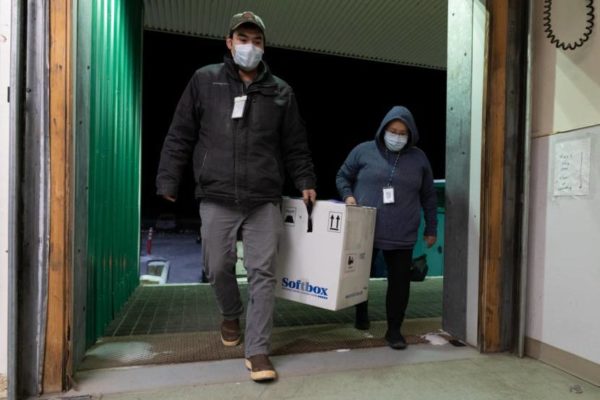
In the final weeks of the Trump presidency, the administration announced a policy that would have had the effect of rewarding states that vaccinated people quickly. Of all 50 states, Alaska still has the highest per capita vaccination numbers. So, the change might have gotten even more doses of the vaccine into Alaskans’ arms.
But two weeks into the Biden administration, the emphasis has shifted to equity over of speed.
In an interview last Friday, Alaska’s Chief Medical Officer Dr. Anne Zink discussed some of the contrasts.
Zink said the Trump administration’s announcement emphasizing speed concerned her. She suggested it could invite gaming the system.
“If I wanted to do a bunch of vaccine really quickly, I would put a bunch of PODs in Anchorage for 20-year-old, tech-savvy people,” she said.
POD is a public health term for “point of dispensing” — basically, a pop-up mass vaccination clinic. Her point was that it’s easier to get vaccine to the state’s urban areas, and younger people might have an easier time navigating an online appointment system.
“I could get a lot of people vaccinated superfast that way, but that’s not going to decrease the morbidity and mortality associated to COVID in the same sort of way,” Zink said. “So, I think that we have to balance equity at the same time. We have to make sure it’s being distributed around the state, which takes more time and energy, and is going to go a bit slower.”
The current system prioritizes people over 65, and includes sending vaccine to rural areas.
With a presidential transition, the push to send more vaccines to states who administered them quickest didn’t happen. The Biden administration is emphasizing equity in its vaccine effort, not just speed.
On Tuesday, the White House announced a partnership to send vaccines directly to pharmacies. They’re picking pharmacies specifically serving the people most at risk, including socially vulnerable communities.
Back in November, the Trump administration ignored advice from the Centers for Disease Control and Prevention to do something similar with state allocations.
Zink hopes some of the previous administration’s decisions which helped Alaska will last — especially in regards to the Indian Health Service.
“There’s a lot of flux still, a lot of changes,” Zink said. “We’re getting to know a lot of new partners in the transition. So, we’ll see.”
Zink said the new administration has said public health officials will get three weeks’ notice instead of a few days for how much vaccine to expect in upcoming shipments. As it is, the short notice makes planning the distribution a scramble.
“We thought we were going to get just over 6,000 doses in December. And then, with less than a week to go, we found out we were getting over 30,000 doses,” she said. “Our January allocation, we found out two days, three days before January. And same with February. So we’ve been on really, really tight [timeline]. It’s hard for communities to plan and stand up point-of-care dispensing quickly.”
She said she’s also working with the new administration to be more transparent on military and veterans vaccination data, which hasn’t been shared with state officials.
Zink said she’s excited to have more clarity from federal authorities, but it will take some to shake out.
For example, in a public health panel discussion Wednesday, Zink fielded a question about if Alaska can expect more vaccine this month.
“What I would start by saying is, we don’t know,” she said. “I’ve been in conversation today about potentially additional vaccine coming in the state at some point, as well as partnership with the federal pharmacy partnership, which may get vaccine separately.”
She wrapped up her answer by saying, “We don’t know.”
Jeremy Hsieh is the deputy managing editor of the KTOO newsroom in Juneau. He’s a podcast fiend who’s worked in journalism since high school as a reporter, editor and television producer. He ran Gavel Alaska for 360 North from 2011 to 2016, and is big on experimenting with novel tools and mediums (including the occasional animated gif) to tell stories and demystify the news. Jeremy’s an East Coast transplant who moved to Juneau in 2008.





